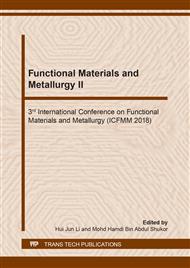[1]
Moskalyk, R.R. and A.M. Alfantazi, Processing of vanadium: a review. Minerals Engineering, 2003. 16(9): pp.793-805.
DOI: 10.1016/s0892-6875(03)00213-9
Google Scholar
[2]
Xinsheng Li, B.X., Extraction of vanadium from high calcium vanadium slag using direct roasting and soda leaching. (2012).
DOI: 10.1007/s12613-012-0600-8
Google Scholar
[3]
Song, W.-c., et al., Extraction of vanadium from molten vanadium bearing slag by oxidation with pure oxygen in the presence of CaO. Transactions of Nonferrous Metals Society of China, 2014. 24(8): pp.2687-2694.
DOI: 10.1016/s1003-6326(14)63399-9
Google Scholar
[4]
Wang, M., et al., A novel technology for vanadium and chromium recovery from V-Cr-bearing reducing slag. Hydrometallurgy, 2017. 171: pp.116-122.
DOI: 10.1016/j.hydromet.2017.05.007
Google Scholar
[5]
Ji, Y., et al., Cleaner and effective process for extracting vanadium from vanadium slag by using an innovative three-phase roasting reaction. Journal of cleaner production, 2017. 149: pp.1068-1078.
DOI: 10.1016/j.jclepro.2017.02.177
Google Scholar
[6]
Li, H.-Y., et al., Asynchronous extraction of vanadium and chromium from vanadium slag by stepwise sodium roasting–water leaching. Hydrometallurgy, 2015. 156: pp.124-135.
DOI: 10.1016/j.hydromet.2015.06.003
Google Scholar
[7]
Liu, L., et al., Intensified decomposition of vanadium slag via aeration in concentrated NaOH solution. International Journal of Mineral Processing, 2017. 160: pp.1-7.
DOI: 10.1016/j.minpro.2017.01.003
Google Scholar
[8]
Liu, Z., et al., Enhanced leaching of vanadium slag in acidic solution by electro-oxidation. Hydrometallurgy, 2016. 159: pp.1-5.
DOI: 10.1016/j.hydromet.2015.09.019
Google Scholar
[9]
Li, M., et al., A cleaner vanadium extraction method featuring non-salt roasting and ammonium bicarbonate leaching. Journal of cleaner production, 2017. 149: pp.206-217.
DOI: 10.1016/j.jclepro.2017.02.093
Google Scholar
[10]
Yang, Z., et al., Leaching kinetics of calcification roasted vanadium slag with high CaO content by sulfuric acid. International Journal of Mineral Processing, 2014. 133: pp.105-111.
DOI: 10.1016/j.minpro.2014.10.011
Google Scholar
[11]
He, A., et al., A novel method of synthesis and investigation on transformation of synthetic rutile powders from Panzhihua sulphate titanium slag using microwave heating. Powder Technology, 2018. 323: pp.115-119.
DOI: 10.1016/j.powtec.2017.10.020
Google Scholar
[12]
Zhao, W., et al., Effect of microwave irradiation on selective heating behavior and magnetic separation characteristics of Panzhihua ilmenite. Applied Surface Science, 2014. 300: pp.171-177.
DOI: 10.1016/j.apsusc.2014.02.038
Google Scholar
[13]
Pickles, C.A., Microwaves in extractive metallurgy: Part 2 – A review of applications. Minerals Engineering, 2009. 22(13): pp.1112-1118.
DOI: 10.1016/j.mineng.2009.02.014
Google Scholar
[14]
Yang, K., et al., Microwave roasting and leaching of an oxide-sulphide zinc ore. Hydrometallurgy, 2016. 166: pp.243-251.
DOI: 10.1016/j.hydromet.2016.07.012
Google Scholar
[15]
Lin, G., et al., Microwave roasting of siderite and the catalytic combustion effects on anthracite. Applied Thermal Engineering, 2017. 117: pp.668-674.
DOI: 10.1016/j.applthermaleng.2017.02.083
Google Scholar
[16]
Zhang, J., et al., Mechanism of vanadium slag roasting with calcium oxide. International Journal of Mineral Processing, 2015. 138: pp.20-29.
DOI: 10.1016/j.minpro.2015.03.007
Google Scholar


